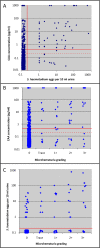Sensitivity and Specificity of a Urine Circulating Anodic Antigen Test for the Diagnosis of Schistosoma haematobium in Low Endemic Settings
- PMID: 25973845
- PMCID: PMC4431728
- DOI: 10.1371/journal.pntd.0003752
Sensitivity and Specificity of a Urine Circulating Anodic Antigen Test for the Diagnosis of Schistosoma haematobium in Low Endemic Settings
Abstract
Background: Elimination of schistosomiasis as a public health problem and interruption of transmission in selected areas are key goals of the World Health Organization for 2025. Conventional parasitological methods are insensitive for the detection of light-intensity infections. Techniques with high sensitivity and specificity are required for an accurate diagnosis in low-transmission settings and verification of elimination. We determined the accuracy of a urine-based up-converting phosphor-lateral flow circulating anodic antigen (UCP-LF CAA) assay for Schistosoma haematobium diagnosis in low-prevalence settings in Zanzibar, Tanzania.
Methodology: A total of 1,740 urine samples were collected in 2013 from children on Pemba Island, from schools where the S. haematobium prevalence was <2%, 2-5%, and 5-10%, based on a single urine filtration. On the day of collection, all samples were tested for microhematuria with reagent strips and for the presence of S. haematobium eggs with microscopy. Eight months later, 1.5 ml of urine from each of 1,200 samples stored at -20°C were analyzed by UCP-LF CAA assay, while urine filtration slides were subjected to quality control (QCUF). In the absence of a true 'gold' standard, the diagnostic performance was calculated using latent class analyses (LCA).
Principal findings: The 'empirical' S. haematobium prevalence revealed by UCP-LF CAA, QCUF, and reagent strips was 14%, 5%, and 4%, respectively. LCA revealed a sensitivity of the UCP-LF CAA, QCUF, and reagent strips of 97% (95% confidence interval (CI): 91-100%), 86% (95% CI: 72-99%), and 67% (95% CI: 52-81%), respectively. Test specificities were consistently above 90%.
Conclusions/significance: The UCP-LF CAA assay shows high sensitivity for the diagnosis of S. haematobium in low-endemicity settings. Empirically, it detects a considerably higher number of infections than microscopy. Hence, the UCP-LF CAA employed in combination with QCUF, is a promising tool for monitoring and surveillance of urogenital schistosomiasis in low-transmission settings targeted for elimination.
Conflict of interest statement
The authors have declared that no competing interests exist.
Figures



References
-
- Multiple Partners. Uniting to combat neglected tropical diseases. Ending the neglect & reaching 2020 goals. Table of commitments. London, United Kingdom. 30 January 2012. Available: https://www.gov.uk/government/uploads/system/uploads/attachment_data/fil.... Accessed: 14 April 2015.
-
- WHO. Schistosomiasis: progress report 2001–2011 and strategic plan 2012–2020 Geneva: World Health Organization; 2013. pp 1–80.
Publication types
MeSH terms
Substances
LinkOut - more resources
Full Text Sources
Other Literature Sources
Medical
Research Materials

